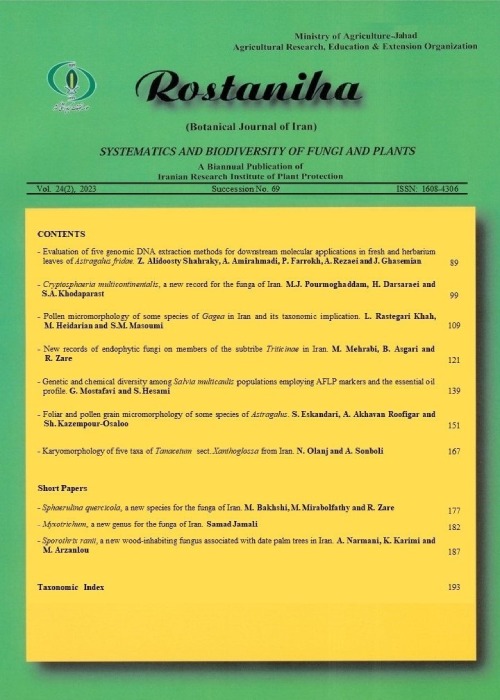فهرست مطالب
نشریه رستنیها
سال بیست و سوم شماره 1 (پیاپی 65، پاییز 1401)
- تاریخ انتشار: 1401/09/06
- تعداد عناوین: 1
-
-
صفحات 1-131
مطالعه حاضر، در کوههای دمیرلی واقع در استان زنجان در شمال غرب ایران، به منظور معرفی فلور، غنای گونهای، میزان اندمیسم و بررسی وضعیت فیتوژیوگرافی منطقه انجام شد. براساس این مطالعه در مجموع، 809 آرایه از گیاهان آوندی متعلق به 69 تیره و 333 جنس از منطقه دمیرلی معرفی میگردد. از نظر شکل زیستی، همیکریپتوفیتها با 399 گونه، رتبه نخست را دارند. تروفیتها، کامفیتها و در نهایت فانروفیتها، به ترتیب با 194، 199 و 19 گونه در رتبههای بعدی قرار دارند. الگوی توزیع ارتفاعی گونههای مورد مطالعه در منطقه دمیرلی یکسان نبود و بر این اساس، ده الگوی مختلف تشخیص داده شد. این مطالعه نشان داد که با افزایش ارتفاع، آشکارا غنای گونهای کاهش پیدا کرده و در طول یک گرادیان ارتفاعی حدودا 1600 متری، نصف میشود. شصت و نه درصد از فلور منطقه، به ناحیه ایرانی-تورانی تعلق دارد و گونههای اروپا-سیبری/ایرانی-تورانی/مدیترانهای، ایرانی-تورانی/مدیترانهای و اروپا-سیبری/ایرانی-تورانی به ترتیب با 9، 7 و 6 درصد، سهم قابل توجهی در فلور منطقه دارند. پنج درصد از فلور منطقه به گونههای چندناحیهای و 3/2 درصد به گونههای جهانوطن یا تقریبا جهانوطنی تعلق دارد. در ارتفاعات پایین، فلور منطقه متاثر از ناحیه مدیترانهای، بخشهای شرقی و مرکزی ناحیه ایرانی-تورانی و حتی ناحیه صحارا-سندی است. با افزایش ارتفاع، ترکیب فلوریستیک منطقه تغییر یافته و گونههای بخشهای غربی ناحیه ایرانی-تورانی و گونههای جهانوطن و چندناحیهای غلبه پیدا میکنند. در منطقه دمیرلی، 121 آرایه از گیاهان انحصاری ایران حضور دارند که از بین آنها، 11 گونه اندمیک و هشت گونه نیمهاندمیک استان زنجان هستند. براساس این مطالعه، مشخص شد که بین عامل ارتفاع و میزان اندمیسم همبستگی معنیداری وجود دارد و با صد متر افزایش ارتفاع، میزان اندمیسم هم به میزان 8/3 درصد افزایش مییابد.
کلیدواژگان: اندمیسم، تنوع زیستی، پوشش گیاهی، جغرافیای گیاهی، غنای گونه ای، فلور
-
Pages 1-131
The present study, was aimed to investigate flora and phytogeography of the Damirli mountains, located in Zanjan province in northwestern of Iran. In this area, the total amount of 809 taxa of vascular plant belonging to 69 families and 333 genera are introduced. Hemicryptophytes with 399 species are ranked first in life forms. Therophytes, chamaephytes, phanerophytes with 194, 199, and 19 species are ranked next, respectively. The patterns of altitudinal distribution of the species were not similar and 10 different patterns were recognized. This study revealed that, as the altitude increases, the species richness decreases and along ca 1600 meters, elevational gradient is almost reduced to half. Sixty-nine percent of the flora of the region belongs to Irano-Turanian region and Euro-Siberian/Irano-Turanian/Mediterranea, Irano-Turanian/ Mediterranean, and Euro-Siberian/Irano-Turanian species have considerable share in flora of the studied region (9%, 7%, and 6%, respectively). Five percent of the flora of the region belong to the pluriregional species and 2.3% belong to cosmopolitan or subcosmopolitan. In lower places, the flora of the area is influenced by Mediterranean region, western and central parts of Irano-Turanian, and even Saharo-Sindian region. As the altitude rises, the floristic composition of the region is changed, and the species of the western parts of the Irano-Turanian region and cosmopolitan species as well as pluriregional dominate. In the Damirli region, 121 taxa of Iranian endemic plants exist among which 11 species are endemic and eight others are subendemic to Zanjan province. The present study, therefore, revealed that, there is a meaningful relationship between altitude and the endemism so that, as the altitude increases for 100 meters, there is a 3.8% increase in the amount of endemism.
Keywords: Biodiversity, endemism, flora, phytogeography, species richness, vegetation


